Fractal Characteristic Analysis of Urban Land-Cover Spatial Patterns with Spatiotemporal Remote Sensing Images in Shenzhen City (1988–2015)
Abstract
:1. Introduction
2. Materials and Methods
2.1. Study Area
2.2. Data and Processing
3. Methodology
3.1. Fractal Measurement
3.2. Fractal Measurement Method of Urban Land-Cover Spatial Structure
3.3. The Information Entropy for Urban Land-Cover Structure
4. Results and Analysis
4.1. Fractal Dimension Analysis of Urban Land-Cover Spatial Structure
4.2. Information Entropy Results of Urban Land-Cover Spatial Structure
4.3. Analysis of Factors Associated with Urban Spatial Structure
4.3.1. Fractal Analysis for Urban Land Cover
4.3.2. Power-Law Analysis with Population Size and GDP
4.3.3. Management Implications
5. Discussion
6. Conclusions
Author Contributions
Funding
Institutional Review Board Statement
Informed Consent Statement
Data Availability Statement
Acknowledgments
Conflicts of Interest
References
- Deng, F.F.; Huang, Y. Uneven land reform and urban sprawl in China: The case of Beijing. Prog. Plan. 2004, 61, 211–236. [Google Scholar] [CrossRef]
- Frumkin, H. Urban sprawl and public health. Public Health Rep. 2002, 117, 201–217. [Google Scholar] [CrossRef]
- Dear, M.; Scott, A.J. Urbanization and Urban Planning in Capitalist Society; Routledge: London, UK, 2018; Volume 7. [Google Scholar]
- Bourne, L.S. Internal Structure of the City: Readings on Urban Form, Growth, and Policy; Oxford University Press: Oxford, UK, 1982. [Google Scholar]
- Chen, Y. Multi-scaling allometric analysis for urban and regional development. Physica A 2017, 465, 673–689. [Google Scholar] [CrossRef] [Green Version]
- Batty, M. New ways of looking at cities. Nature 1995, 377, 574. [Google Scholar] [CrossRef]
- Bosch, M.; Jaligot, R.; Chenal, J. Spatiotemporal patterns of urbanization in three Swiss urban agglomerations: Insights from landscape metrics, growth modes and fractal analysis. Landsc. Ecol. 2020, 34, 879–891. [Google Scholar] [CrossRef]
- Mu, L.; Wang, L.; Wang, Y.; Chen, X.; Han, W. Urban Land Use and Land Cover Change Prediction via Self-Adaptive Cellular Based Deep Learning With Multisourced Data. IEEE J. Sel. Top. Appl. Earth Obs. Remote Sens. 2019, 12, 5233–5247. [Google Scholar] [CrossRef]
- Li, X.; Tang, Z.; Chen, W.; Wang, L. Multimodal and Multi-Model Deep Fusion for Fine Classification of Regional Complex Landscape Areas Using ZiYuan-3 Imagery. Remote Sens. 2019, 11, 2716. [Google Scholar] [CrossRef] [Green Version]
- Chen, W.; Li, X.; Wang, L. Fine Land Cover Classification in an Open Pit Mining Area Using Optimized Support Vector Machine and WorldView-3 Imagery. Remote Sens. 2020, 12, 82. [Google Scholar] [CrossRef] [Green Version]
- Wang, L.; Chen, L. The impact of new transportation modes on population distribution in Jing-Jin-Ji region of China. Sci. Data. 2018, 5, 170204. [Google Scholar] [CrossRef] [PubMed] [Green Version]
- Liu, P.; Wang, M.; Wang, L.; Han, W. Remote-Sensing Image Denoising with Multi-Sourced Information. IEEE J. Sel. Top. Appl. Earth Observ. Remote Sens. 2019, 12, 660–674. [Google Scholar] [CrossRef]
- Cheng, L.; Wang, L.; Feng, R.; Yan, J. Remote Sensing and Social Sensing Data Fusion for Fine-Resolution Population Mapping With a Multimodel Neural Network. IEEE J. Sel. Top. Appl. Earth Obs. Remote Sens. 2021, 14, 5973–5987. [Google Scholar] [CrossRef]
- White, R.; Engelen, G. Cellular automata and fractal urban form: A cellular modelling approach to the evolution of urban land-use patterns. Environ. Plan. A 1993, 25, 1175–1199. [Google Scholar] [CrossRef] [Green Version]
- Frankhauser, P. From Fractal Urban Pattern Analysis to Fractal Urban Planning Concepts. In Computational Approaches for Urban Environments; Helbich, M., Jokar Arsanjani, J., Leitner, M., Eds.; Springer International Publishing: Cham, Switzerland, 2015; pp. 13–48. [Google Scholar]
- Lagarias, A.; Prastacos, P. Comparing the urban form of South European cities using fractal dimensions. Environ. Plan B-Urban. 2020, 47, 1149–1166. [Google Scholar] [CrossRef]
- White, R.; Engelen, G.; Uljee, I. The use of constrained cellular automata for high-resolution modelling of urban land-use dynamics. Environ. Plan. B 1997, 24, 323–343. [Google Scholar] [CrossRef]
- Chen, Y.; Li, X.; Liu, X.; Ai, B. Modeling urban land-use dynamics in a fast developing city using the modified logistic cellular automaton with a patch-based simulation strategy. Int. J. Geogr. Inf. Sci. 2014, 28, 234–255. [Google Scholar] [CrossRef]
- Liu, Y.; He, Q.; Tan, R.; Liu, Y.; Yin, C. Modeling different urban growth patterns based on the evolution of urban form: A case study from Huangpi, Central China. Appl. Geogr. 2016, 66, 109–118. [Google Scholar] [CrossRef]
- Chen, Y. Fractal dimension evolution and spatial replacement dynamics of urban growth. Chaos Soliton Fract. 2012, 45, 115–124. [Google Scholar] [CrossRef] [Green Version]
- Batty, M.; Longley, P.A. Fractal Cities: A Geometry of Form and Function; Academic Press: Cambridge, MA, USA, 1994. [Google Scholar]
- Batty, M. Cities as fractals: Simulating growth and form. In Fractals and Chaos; Springer: Berlin/Heidelberg, Germany, 1991; pp. 43–69. [Google Scholar]
- Chen, Y.; Wang, J. Multifractal characterization of urban form and growth: The case of Beijing. Environ. Plan. B Plan. Des. 2013, 40, 884–904. [Google Scholar] [CrossRef]
- Shen, G. Fractal dimension and fractal growth of urbanized areas. Int. J. Geogr. Inf. Sci. 2002, 16, 419–437. [Google Scholar] [CrossRef]
- Irwin, E.G.; Bockstael, N.E. The evolution of urban sprawl: Evidence of spatial heterogeneity and increasing land fragmentation. Proc. Natl. Acad. Sci. USA 2007, 104, 20672–20677. [Google Scholar] [CrossRef] [Green Version]
- Sémécurbe, F.; Tannier, C.; Roux, S.G. Applying two fractal methods to characterise the local and global deviations from scale invariance of built patterns throughout mainland France. J. Geogr. Syst. 2019, 21, 271–293. [Google Scholar] [CrossRef] [Green Version]
- Benguigui, L.; Czamanski, D.; Marinov, M.; Portugali, Y. When and where is a city fractal? Environ. Plan. B 2000, 27, 507–519. [Google Scholar] [CrossRef] [Green Version]
- Chen, Y.; Wang, Y.; Li, X. Fractal dimensions derived from spatial allometric scaling of urban form. Chaos Soliton Fract. 2019, 126, 122–134. [Google Scholar] [CrossRef] [Green Version]
- Murcio, R.; Masucci, A.P.; Arcaute, E.; Batty, M. Multifractal to monofractal evolution of the London street network. Phys. Rev. E 2015, 92, 062130. [Google Scholar] [CrossRef] [PubMed] [Green Version]
- Zhao, J.; Chen, Y.; Li, S. Bi-fractal structure and evolution of the Beijing–Tianjin–Hebei region urban land-use patterns. Prog. Geogr. 2019, 38, 77. [Google Scholar]
- Nie, Q.; Xu, J.; Liu, Z. Fractal and multifractal characteristic of spatial pattern of urban impervious surfaces. Earth Sci. Inform. 2015, 8, 381–392. [Google Scholar] [CrossRef]
- Purevtseren, M.; Tsegmid, B.; Indra, M.; Sugar, M. The fractal geometry of urban land use: The case of Ulaanbaatar city, Mongolia. Land 2018, 7, 67. [Google Scholar] [CrossRef] [Green Version]
- Cheng, L.; Wang, L.; Feng, R. Fractal Characteristics and Evolution of Urban Land-Use: A Case Study in the Shenzhen City (1988–2015). In Proceedings of the IEEE International Geoscience and Remote Sensing Symposium, IGARSS 2020, Waikoloa, HI, USA, 26 September–2 October 2020; pp. 4275–4278. [Google Scholar] [CrossRef]
- Chen, Y.; Wang, J.; Feng, J. Understanding the Fractal Dimensions of Urban Forms through Spatial Entropy. Entropy 2017, 19, 600. [Google Scholar] [CrossRef] [Green Version]
- Meng, L.; Sun, Y.; Zhao, S. Comparing the spatial and temporal dynamics of urban expansion in Guangzhou and Shenzhen from 1975 to 2015: A case study of pioneer cities in China’s rapid urbanization. Land Use Pol. 2020, 97, 104753. [Google Scholar] [CrossRef]
- Chuang-Lin, F. The urbanization and urban development in China after the reform and opening-up. Econ. Geogr. 2009, 29, 19–25. [Google Scholar]
- Deng, Y.; Fu, B.; Sun, C. Effects of urban planning in guiding urban growth: Evidence from Shenzhen, China. Cities 2018, 83, 118–128. [Google Scholar] [CrossRef]
- Ng, M.K. Sustainable urban development issues in Chinese transitional cities: Hong Kong and Shenzhen. Int. Plan. Stud. 2002, 7, 7–36. [Google Scholar] [CrossRef]
- Han, T.; Wulder, M.A.; White, J.C.; Coops, N.C.; Álvarez-Taboada, M.F.; Butson, C. An Efficient Protocol to Process Landsat Images for Change Detection With Tasselled Cap Transformation. IEEE Geosci. Remote Sens. Lett. 2007, 4, 147–151. [Google Scholar] [CrossRef]
- Dou, P.; Chen, Y. Dynamic monitoring of land-use/land-cover change and urban expansion in Shenzhen using Landsat imagery from 1988 to 2015. Int. J. Remote Sens. 2017, 38, 5388–5407. [Google Scholar] [CrossRef]
- Jevric, M.; Romanovich, M. Fractal dimensions of urban border as a criterion for space management. Procedia Eng. 2016, 165, 1478–1482. [Google Scholar]
- Batty, M.; Longley, P.A. The fractal simulation of urban structure. Environ. Plan. A 1986, 18, 1143–1179. [Google Scholar] [CrossRef]
- Chen, Y. Fractal Modeling and fractal dimension description of urban morphology. Entropy 2020, 22, 961. [Google Scholar] [CrossRef]
- Man, W.; Nie, Q.; Li, Z.; Li, H.; Wu, X. Using fractals and multifractals to characterize the spatiotemporal pattern of impervious surfaces in a coastal city: Xiamen, China. Physica A 2019, 520, 44–53. [Google Scholar] [CrossRef]
- Zhang, Z.; Xiao, R.; Yu, W.; Liu, Y.; Lin, M.; Wang, M. Characterizing factors associated with built-up land expansion in urban and non-urban areas from a morphological perspective. Sustainability 2017, 9, 1411. [Google Scholar] [CrossRef] [Green Version]
- Liebovitch, L.S.; Toth, T. A fast algorithm to determine fractal dimensions by box counting. Phys. Lett. A 1989, 141, 386–390. [Google Scholar] [CrossRef]
- Lovejoy, S.; Schertzer, D.; Tsonis, A. Functional box-counting and multiple elliptical dimensions in rain. Science 1987, 235, 1036–1038. [Google Scholar] [CrossRef]
- Cabral, P.; Augusto, G.; Tewolde, M.; Araya, Y.H. Entropy in Urban Systems. Entropy 2013, 15, 5223–5236. [Google Scholar] [CrossRef]
- Zhao, S.; Chai, L. A new assessment approach for urban ecosystem health basing on maximum information entropy method. Stoch. Environ. Res. Risk Assess 2015, 29, 1601–1613. [Google Scholar] [CrossRef]
- Binyao, L. The Calculation Method of Urban Spatial Form and its Evaluation. Urban Plan. Rev. 1998, 41, b38017. [Google Scholar]
- Bourne, L.S.; Simmons, J.W.; Bourne, L.S. Systems of Cities: Readings on Structure, Growth and Policy; Oxford University Press: Oxford, UK, 1978. [Google Scholar]
- Feng, J.; Chen, Y. Spatiotemporal evolution of urban form and land-use structure in Hangzhou, China: Evidence from fractals. Environ. Plan. B 2010, 37, 838–856. [Google Scholar] [CrossRef]
- Portugali, J. Self Organization and the City. In Encyclopedia of Complexity and Systems Science; Meyers, R.A., Ed.; Springer: Berlin/Heidelberg, Germany, 2009; pp. 7953–7991. [Google Scholar]
- Chen, Y. A wave-spectrum analysis of urban population density: Entropy, fractal, and spatial localization. Discrete Dyn. Nat. Soc. 2008, 2008. [Google Scholar] [CrossRef] [Green Version]
- Wang, K.; He, C. A remark on Wang’s fractal variational principle. Fractals 2019, 27, 1950134. [Google Scholar] [CrossRef]
- Chen, Y.; Jiang, S. An analytical process of the spatio-temporal evolution of urban systems based on allometric and fractal ideas. Chaos Soliton Fract. 2009, 39, 49–64. [Google Scholar] [CrossRef]
- Chen, Y. Multifractals of central place systems: Models, dimension spectrums, and empirical analysis. Physica A 2014, 402, 266–282. [Google Scholar] [CrossRef] [Green Version]
- Tan, X.; Huang, B.; Batty, M.; Li, J. Urban Spatial Organization, Multifractals, and Evolutionary Patterns in Large Cities. Ann. Am. Assoc. Geogr. 2020, 111, 1539–1558. [Google Scholar] [CrossRef]
- Moroni, S.; Rauws, W.; Cozzolino, S. Forms of self-organization: Urban complexity and planning implications. Environ. Plan. B-Urban 2020, 47, 220–234. [Google Scholar] [CrossRef]
- Li, G.; Li, F. Urban sprawl in China: Differences and socioeconomic drivers. Sci. Total Environ. 2019, 673, 367–377. [Google Scholar] [CrossRef]
- Tong, D.; Wu, Y.; MacLachlan, I.; Zhu, J. The role of social capital in the collective-led development of urbanising villages in China: The case of Shenzhen. Urban Stud. 2021, 58, 42098021993353. [Google Scholar] [CrossRef]
- Zhang, J.; Yu, L.; Li, X.; Zhang, C.; Shi, T.; Wu, X.; Yang, C.; Gao, W.; Li, Q.; Wu, G. Exploring annual urban expansions in the Guangdong-Hong Kong-Macau Greater Bay Area: Spatiotemporal features and driving factors in 1986–2017. Remote Sens. 2020, 12, 2615. [Google Scholar] [CrossRef]
- Long, H.; Qu, Y. Land use transitions and land management: A mutual feedback perspective. Land Use Policy 2018, 74, 111–120. [Google Scholar] [CrossRef]
- Shi, X.; Xu, Z. Environmental regulation and firm exports: Evidence from the eleventh Five-Year Plan in China. J. Environ. Econ. Manag. 2018, 89, 187–200. [Google Scholar] [CrossRef]
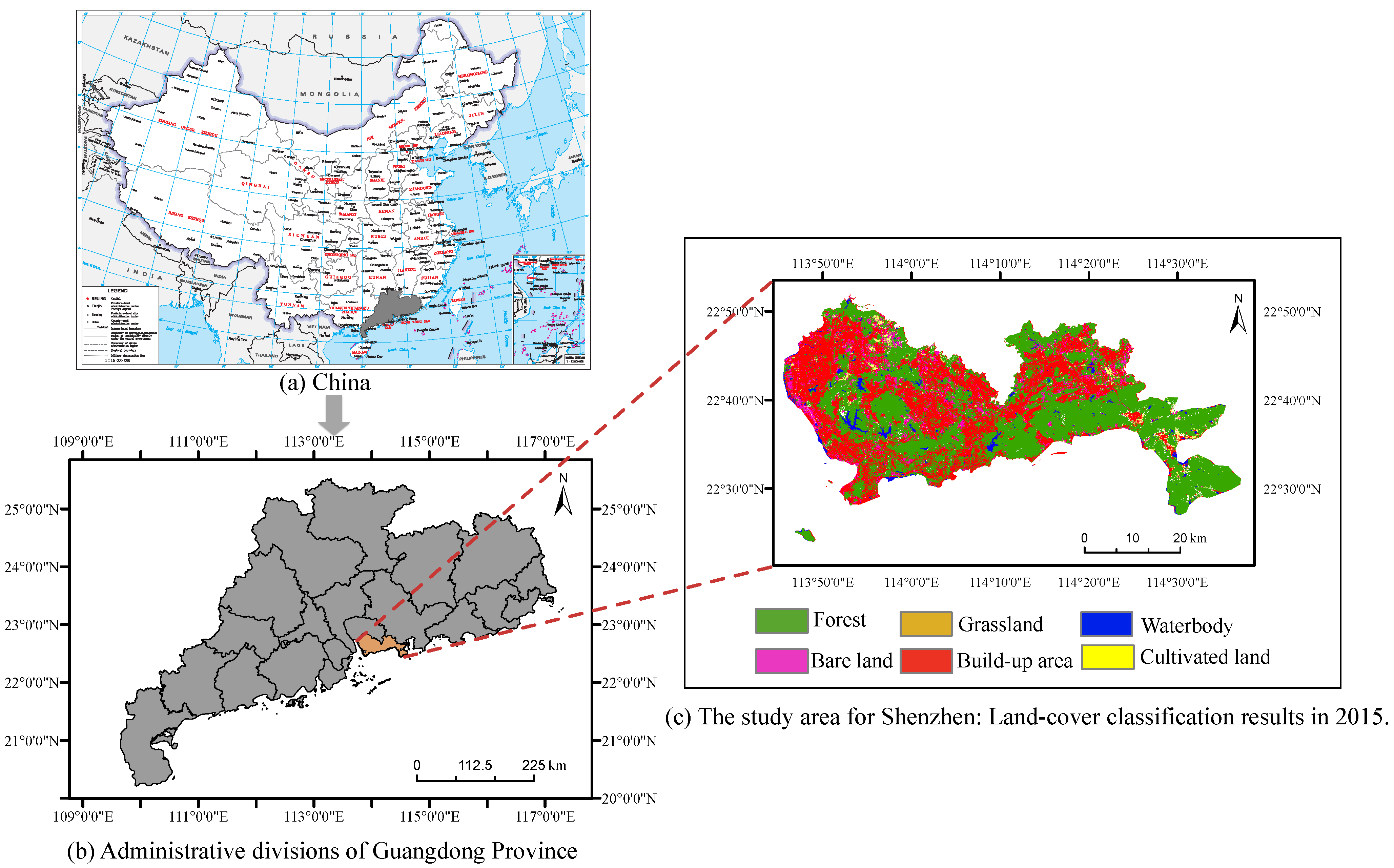
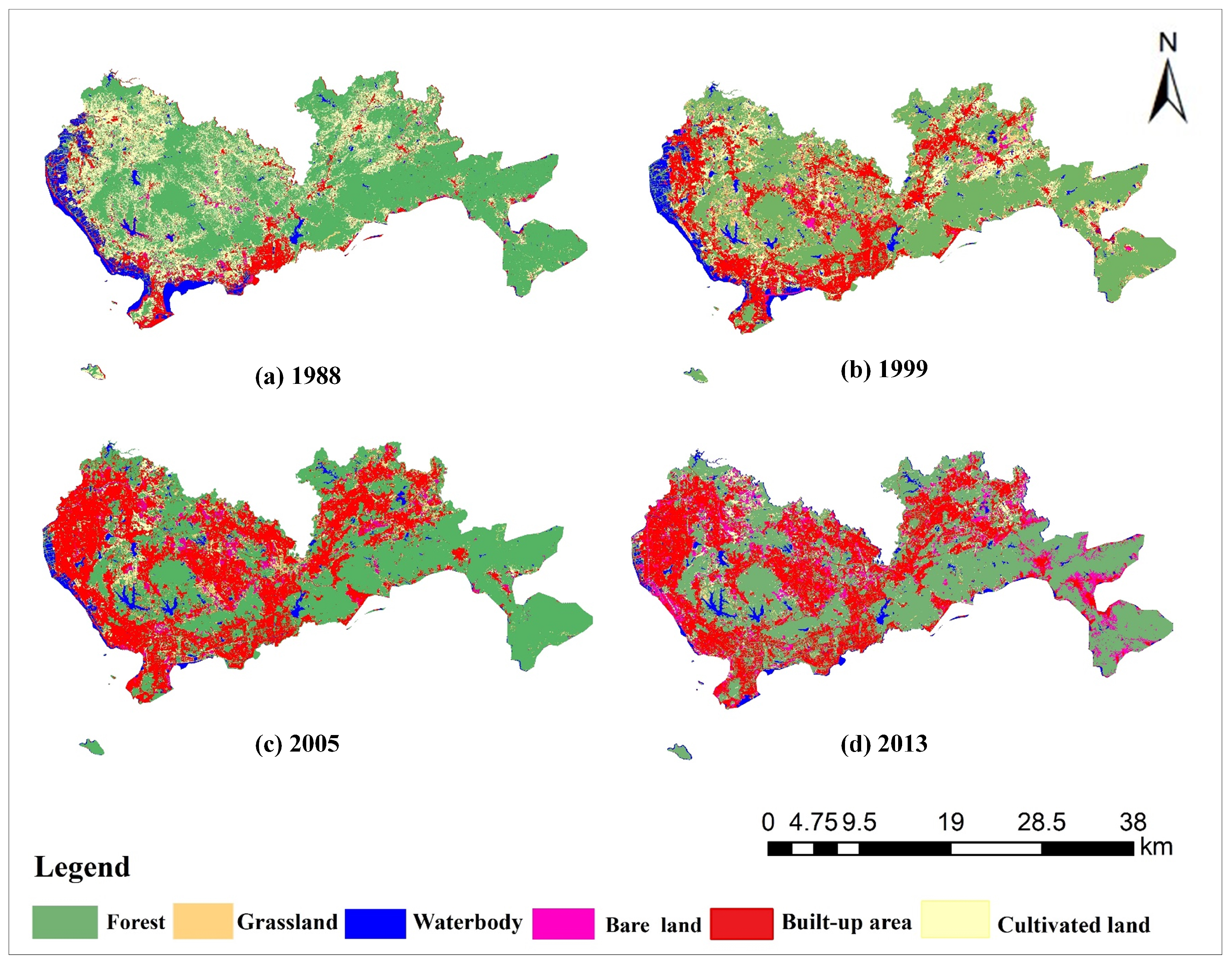

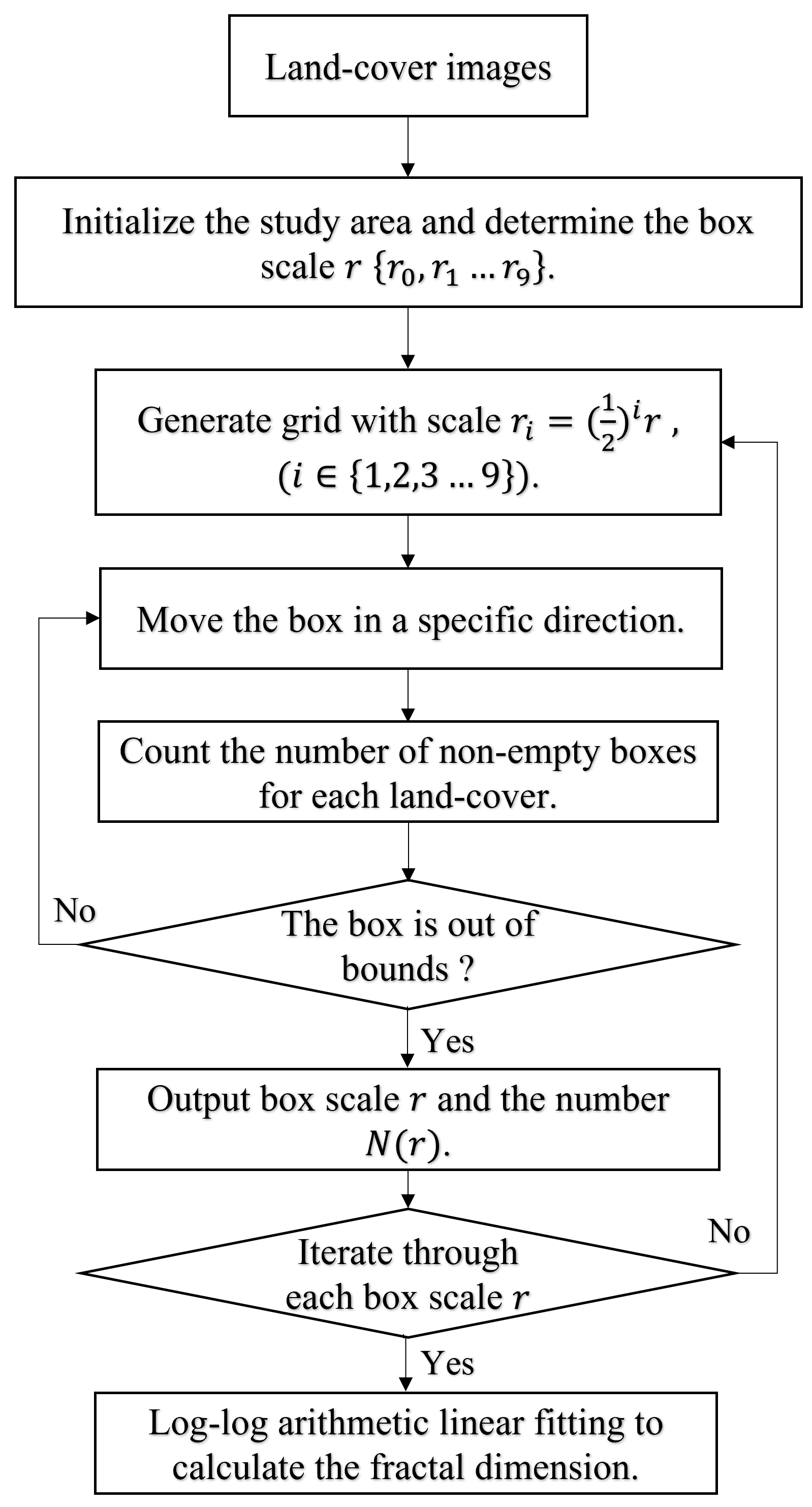
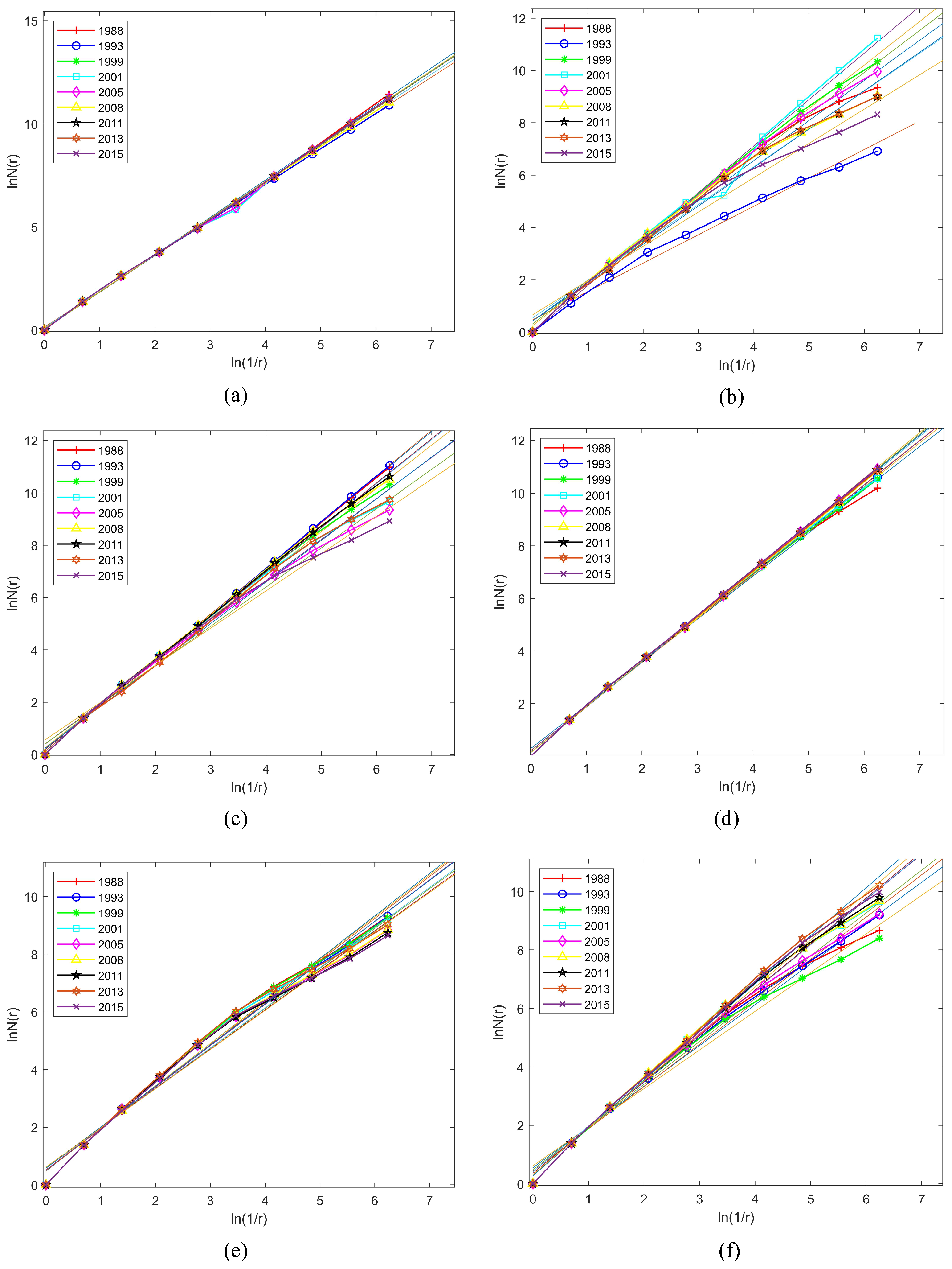
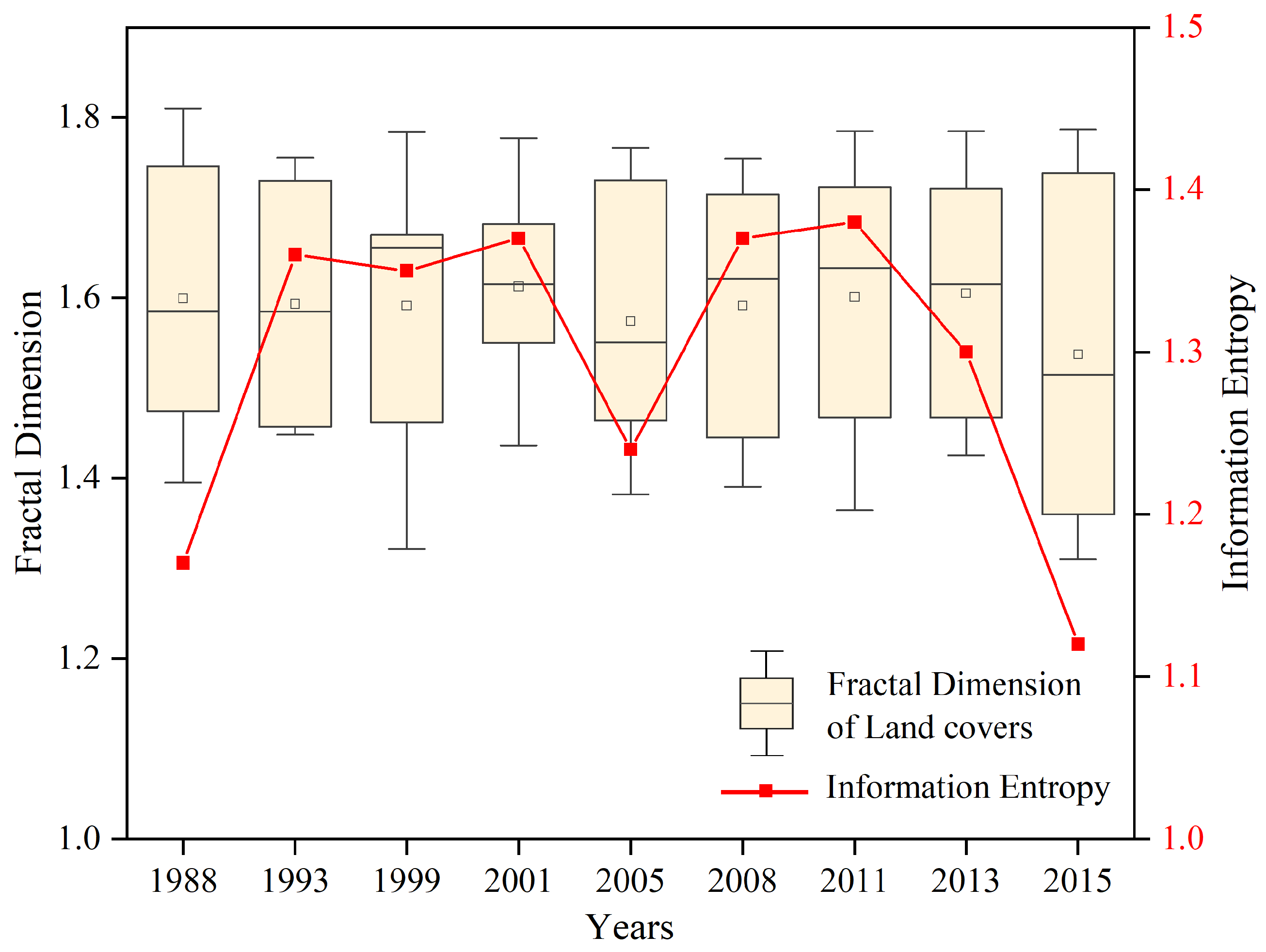
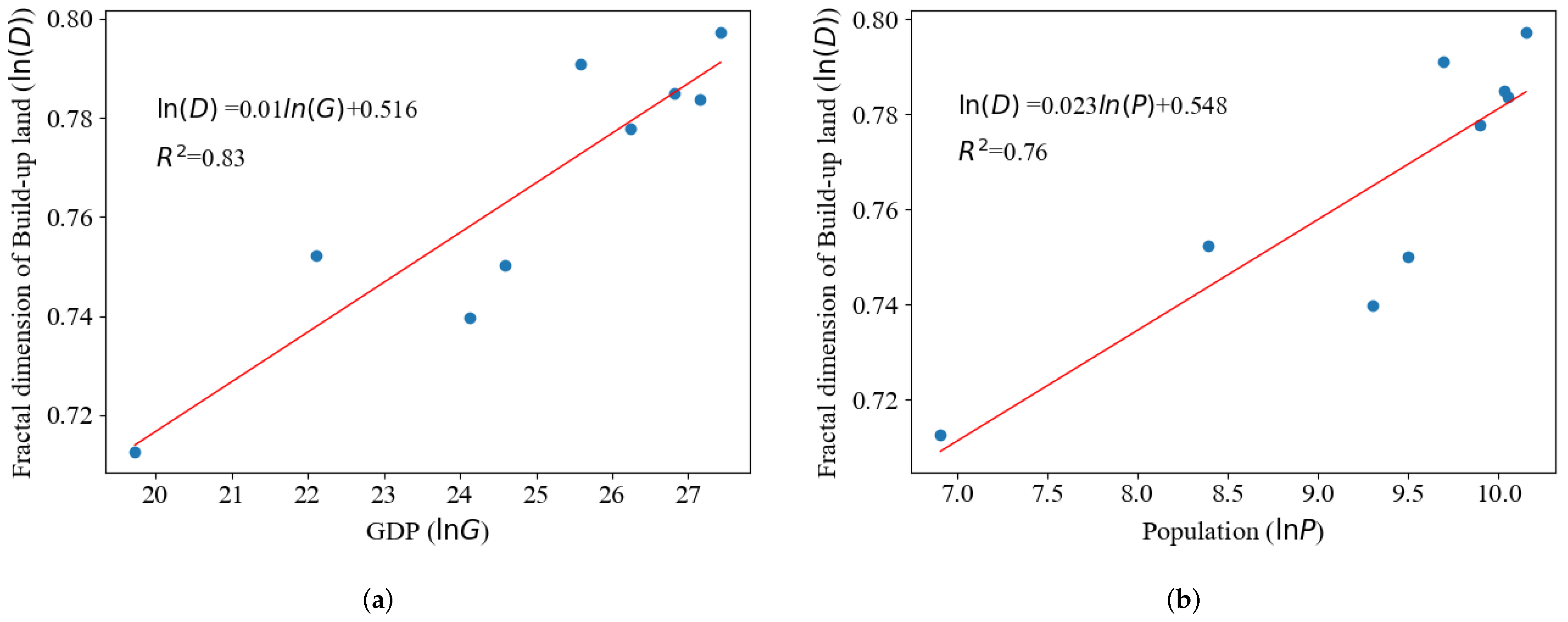
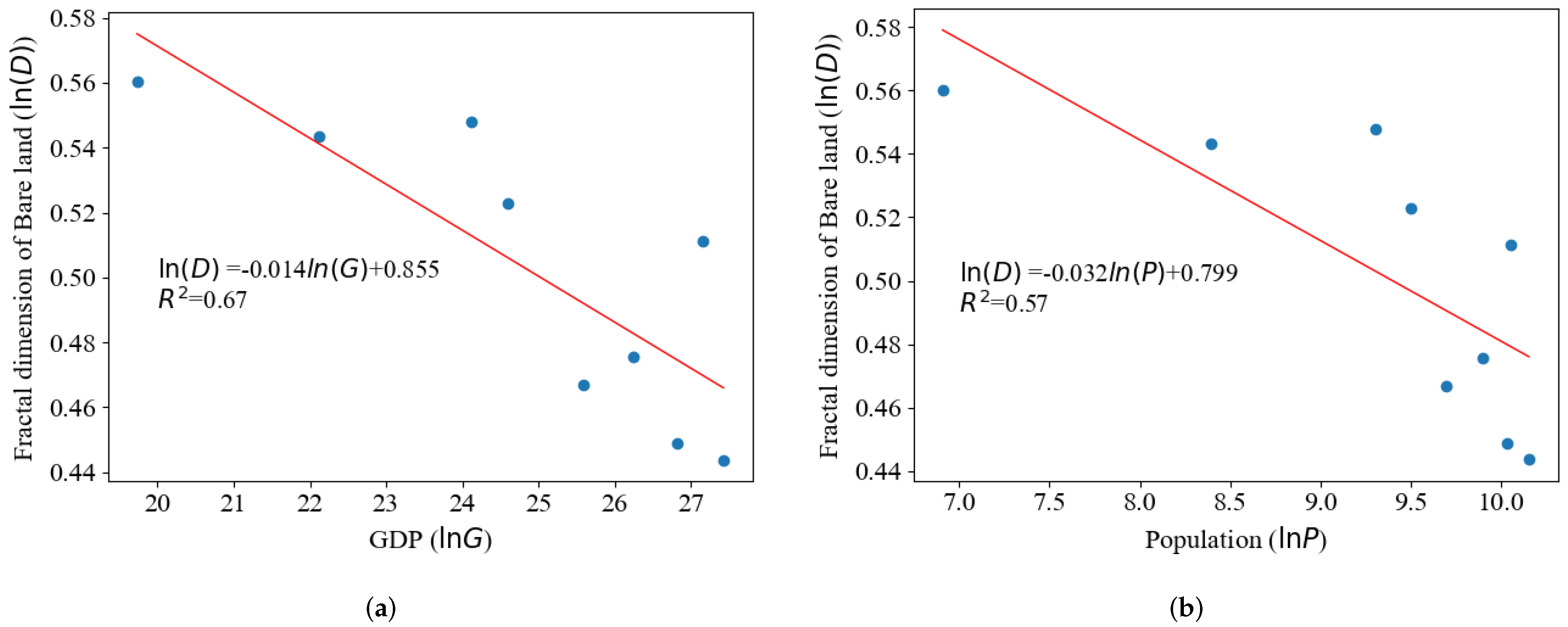
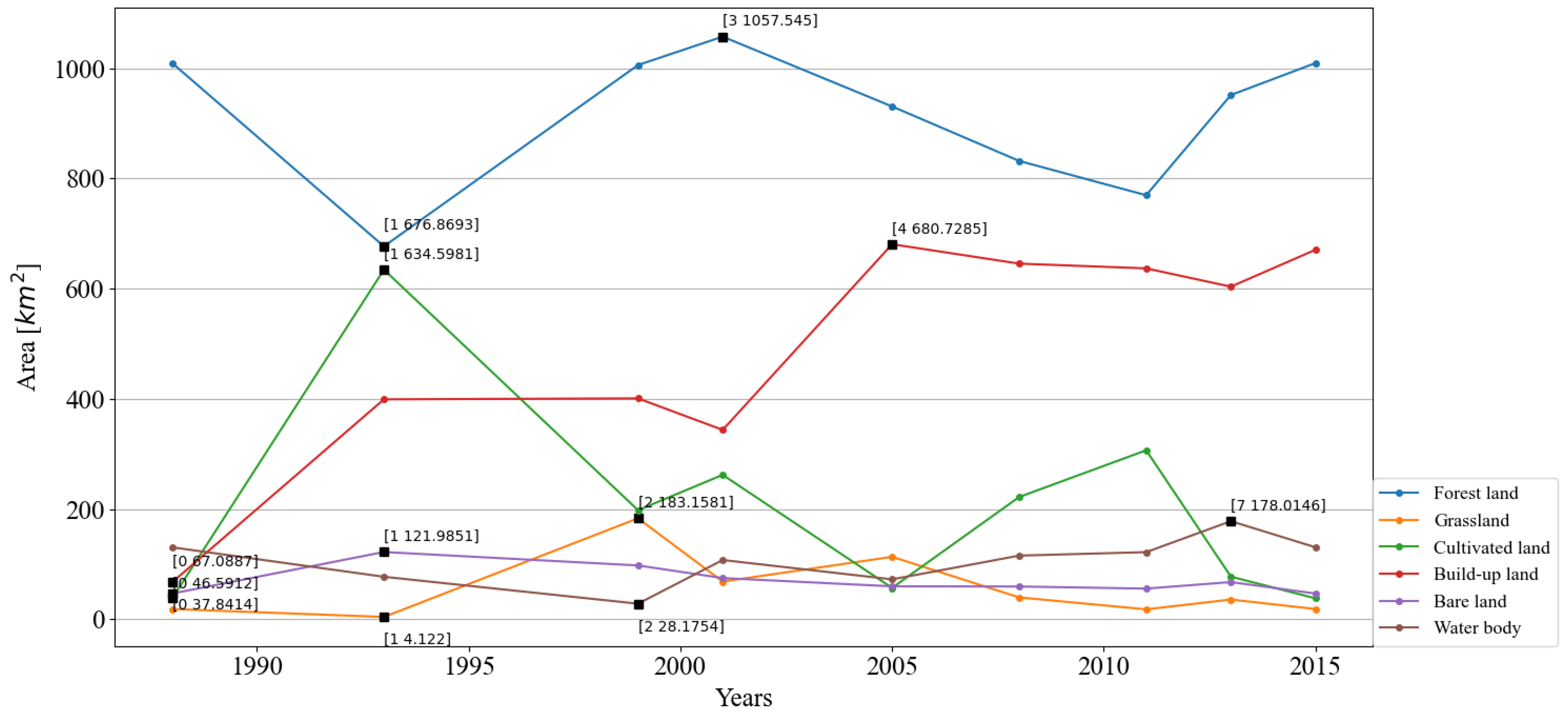
| Year | 1988 | 1993 | 1999 | 2001 | 2005 | 2008 | 2011 | 2013 | 2015 |
|---|---|---|---|---|---|---|---|---|---|
| Platform | Landsat 5 | Landsat 5 | Landsat 5 | Landsat 7 | Landsat 5 | Landsat 5 | Landsat 5 | Landsat 8 | Landsat 8 |
| Sensor | TM | TM | TM | ETM+ | TM | TM | TM | OLI | OLI |
| Spatial resolution(m) | 30 | 30 | 30 | 30 | 30 | 30 | 30 | 30 | 30 |
| Years | Forest Land | Grass Land | Cultivated Land | Build-Up Land | Bare Land | Water Body |
|---|---|---|---|---|---|---|
| 1988 | 53.54% | 1.21% | 21.67% | 8.86% | 5.69% | 8.93% |
| 1993 | 52.31% | 1.24% | 20.16% | 9.01% | 9.38% | 8.01% |
| 1999 | 47.78% | 1.30% | 18.86% | 20.28% | 3.01% | 8.31% |
| 2001 | 45.53% | 1.98% | 17.71% | 23.54% | 3.52% | 7.55% |
| 2005 | 45.49% | 2.10% | 11.04% | 35.16% | 3.55% | 5.97% |
| 2008 | 45.49% | 1.81% | 10.25% | 35.73% | 5.62% | 4.83% |
| 2011 | 45.51% | 2.07% | 10.05% | 36.71% | 3.01% | 3.74% |
| 2013 | 40.02% | 2.07% | 8.26% | 40.10% | 5.81% | 9.16% |
| 2015 | 40.00% | 2.20% | 8.17% | 40.13% | 5.63% | 9.15% |
| Data Level | r | Region Spatial Level | Grid Size (m) (Width × Height) | Grid Count | Number of Nonempty Grid |
|---|---|---|---|---|---|
| 0 | 1 | City level | 91,290.43 × 54,436.84 | 1 | 1 |
| 1 | 1/2 | District level | 45,645.22 × 27,218.42 | 4 | 4 |
| 2 | 1/4 | District level | 22,822.61 × 13,609.21 | 15 | 14 |
| 3 | 1/8 | Sub-district level | 11,411.30 × 6804.60 | 63 | 44 |
| 4 | 1/16 | Sub-district level | 5705.65 × 3402.30 | 255 | 144 |
| 5 | 1/32 | Block level | 2852.83 × 1701.15 | 991 | 850 |
| 6 | 1/64 | Road level | 1426.41 × 850.58 | 3842 | 1798 |
| 7 | 1/128 | Residential compound level | 713.21 × 425.29 | 15,249 | 6761 |
| 8 | 1/512 | Community level | 356.60 × 212.64 | 27,924 | 26,113 |
| 9 | 1/1024 | Community level | 178.30 × 106.32 | 281,744 | 102,535 |
| Years | Forest Land | Grass Land | Cultivated Land | Build-up Land | Bare Land | Water Body | ||||||
|---|---|---|---|---|---|---|---|---|---|---|---|---|
| 1988 | 1.8104 | 0.9995 | 1.5321 | 0.9898 | 1.7459 | 0.9997 | 1.6387 | 0.9971 | 1.4715 | 0.9905 | 1.3951 | 0.9853 |
| 1993 | 1.7297 | 0.9997 | 1.0852 | 0.9872 | 1.7554 | 0.9999 | 1.6845 | 0.9993 | 1.4573 | 0.9914 | 1.4483 | 0.9944 |
| 1999 | 1.7838 | 0.9998 | 1.5602 | 0.9982 | 1.6515 | 0.9982 | 1.6699 | 0.9992 | 1.462 | 0.9897 | 1.3219 | 0.983 |
| 2001 | 1.7772 | 0.9922 | 1.6652 | 0.9935 | 1.682 | 0.9992 | 1.6539 | 0.9993 | 1.4367 | 0.989 | 1.5503 | 0.9926 |
| 2005 | 1.7668 | 0.9998 | 1.6018 | 0.9967 | 1.4992 | 0.9942 | 1.7302 | 0.9997 | 1.3821 | 0.9854 | 1.4641 | 0.9919 |
| 2008 | 1.7545 | 0.9998 | 1.445 | 0.987 | 1.6884 | 0.9987 | 1.7144 | 0.9996 | 1.3905 | 0.9851 | 1.5545 | 0.9933 |
| 2011 | 1.7248 | 0.9997 | 1.2655 | 0.9848 | 1.6975 | 0.9993 | 1.723 | 0.9997 | 1.3649 | 0.9838 | 1.5691 | 0.9956 |
| 2013 | 1.7849 | 0.9997 | 1.4672 | 0.9888 | 1.5891 | 0.9962 | 1.7215 | 0.9997 | 1.4253 | 0.985 | 1.6419 | 0.9975 |
| 2015 | 1.7869 | 0.9997 | 1.3104 | 0.9789 | 1.4236 | 0.986 | 1.7379 | 0.9997 | 1.36 | 0.9816 | 1.6052 | 0.9967 |
| Year | 1988 | 1993 | 1999 | 2001 | 2005 | 2008 | 2011 | 2013 | 2015 |
|---|---|---|---|---|---|---|---|---|---|
| Information entropy | 1.17 | 1.36 | 1.35 | 1.37 | 1.24 | 1.37 | 1.38 | 1.3 | 1.12 |
Publisher’s Note: MDPI stays neutral with regard to jurisdictional claims in published maps and institutional affiliations. |
© 2021 by the authors. Licensee MDPI, Basel, Switzerland. This article is an open access article distributed under the terms and conditions of the Creative Commons Attribution (CC BY) license (https://creativecommons.org/licenses/by/4.0/).
Share and Cite
Cheng, L.; Feng, R.; Wang, L. Fractal Characteristic Analysis of Urban Land-Cover Spatial Patterns with Spatiotemporal Remote Sensing Images in Shenzhen City (1988–2015). Remote Sens. 2021, 13, 4640. https://doi.org/10.3390/rs13224640
Cheng L, Feng R, Wang L. Fractal Characteristic Analysis of Urban Land-Cover Spatial Patterns with Spatiotemporal Remote Sensing Images in Shenzhen City (1988–2015). Remote Sensing. 2021; 13(22):4640. https://doi.org/10.3390/rs13224640
Chicago/Turabian StyleCheng, Luxiao, Ruyi Feng, and Lizhe Wang. 2021. "Fractal Characteristic Analysis of Urban Land-Cover Spatial Patterns with Spatiotemporal Remote Sensing Images in Shenzhen City (1988–2015)" Remote Sensing 13, no. 22: 4640. https://doi.org/10.3390/rs13224640
APA StyleCheng, L., Feng, R., & Wang, L. (2021). Fractal Characteristic Analysis of Urban Land-Cover Spatial Patterns with Spatiotemporal Remote Sensing Images in Shenzhen City (1988–2015). Remote Sensing, 13(22), 4640. https://doi.org/10.3390/rs13224640






